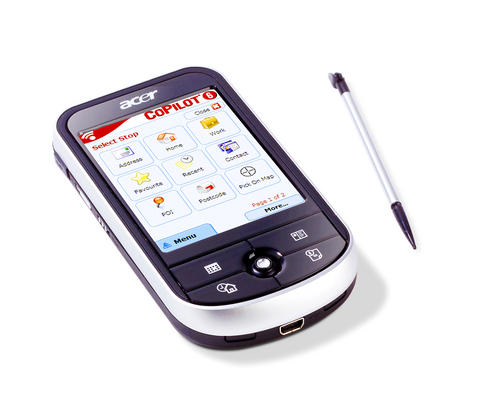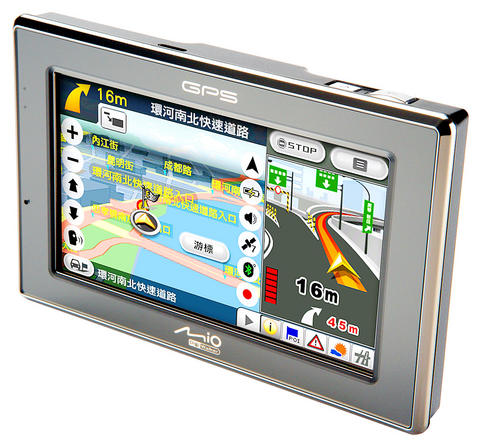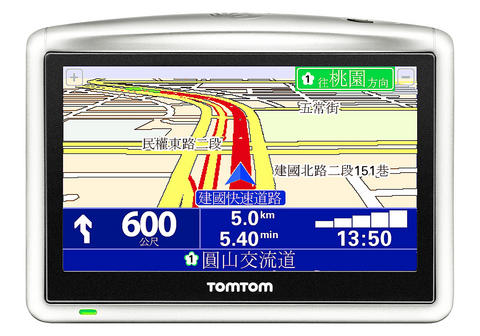The in-car GPS system is without doubt one of the "it" gadgets of the moment, and they will be gracing many a Christmas tree come December. With its wealth of experience in building small electronic devices combining touch screens and wireless technologies, Taiwan was bound to pick up on the trend. Here is a look at how two Taiwanese brands compare to Netherlands-based TomTom, the global leader in GPS devices.
As soon as the packaging is opened, the ONE XL exudes confidence with its simple and sturdy construction. The only physical switch, on the top of the unit, is the power button; all other interaction is handled on the touch screen with a series of gestures and swipes that is both fun and intuitive. Details include the small brow on the top edge of the screen that helps block glare from the sun and provides a useful grip when sliding it into the docking mount.
The accessories that are included with the unit are also of higher-than-average quality. ONE XL gets top marks for the window mount that doesn't look like an architectural joist - it's good-looking enough to leave in place and small enough to safely stow away in the glove box.

In use, the software is clear and precise, though, like any navigation system, it is prone to occasional quirky routes with hilarious comic timing such as the voice thoughtfully directing the driver to turn around on a busy six-lane highway. Passengers also became highly alarmed when what sounded like a steam train barreling down Zhongxiao Road straight at the car turned out to be the auditory warning of an approaching speed camera.
Those considering the ONE XL may well want to look further down the product range. The ONE device lacks the 4.3 inch screen display and some of the features of its more expensive brethren, but the compact dimensions may be a plus for drivers with cramped interiors. Those who do want the extra screen real estate may want to wait for the GO 720 that will be launched this month sporting, among other things, voice control.
Mitac is the premier Taiwanese manufacturer of GPS devices and has many years of experience in the field. The Mio C720T is one of the latest GPS systems and has a couple of features that make it special.

The first of these is a 2 megapixel digital camera on the back of the device. This allows you to take a photo of a business card and use this as the destination of the journey. It's a great idea, but in reality the performance was less than perfect, and it was often quicker to manually enter the address. The other interesting feature was combining the photo with "geo-tagged" information - tracking the location of each photo. It's a fantastic addition, but there needs to a be a little more development work on the services side.
The design is much more angular than the subtler TomTom. Although it had a decent 4.3 inch screen, the chrome detailing meant that on sunny days glare became a problem, and at nighttime the row of LEDs became a little distracting.
Accessories-wise, the window mount is a little bulky and includes multiple screw adjustments for alignment and angle, and it allows you to leave the power plugged in to the dock when the device is removed. Unlike the TomTom, a mains power adaptor is included for charging at home.

The user interface is not as polished as the TomTom and certainly requires a little more learning as a result.
The Acer c500 takes a slightly different approach from the dedicated unit. In this case, the company employs a Microsoft Windows PDA and uses the included Papago software and GPS antenna to do the work. The styling is pretty neat, and it is certainly small enough to stow away in a purse or bag, with the obvious advantage of being able to run other software on top of the navigation functions. As ever, there are trade-offs to be had between small size and large display.
The downside of multi-functions is that the device is not quite so good at pure navigation, and forgoes the touch screen interaction in favor of stylus-led input. This is all very well when sitting at home planning the route, but mid-journey adjustment becomes more difficult when poking around with a stick on the small 2.8 inch screen. However, Papago is arguably the most highly developed mapping software for Taiwan, and it is likely to pick up on many of the charming intricacies of the road system.
The rapid growth of smart phones has, no doubt, squeezed the PDA market a great deal. As a result, for a little more money, it is possible to get a similarly-sized device that can also place phone calls. For those migrating from PDAs without GPS functionality, however, this would be a very handy upgrade.
Regardless of which device you choose, the next generation will carry not memories of parents battling with maps and road signs, but with an inanimate bit of plastic.
Jonathan Biddle is head of Industrial Design at DEM INC

Oct. 27 to Nov. 2 Over a breakfast of soymilk and fried dough costing less than NT$400, seven officials and engineers agreed on a NT$400 million plan — unaware that it would mark the beginning of Taiwan’s semiconductor empire. It was a cold February morning in 1974. Gathered at the unassuming shop were Economics minister Sun Yun-hsuan (孫運璿), director-general of Transportation and Communications Kao Yu-shu (高玉樹), Industrial Technology Research Institute (ITRI) president Wang Chao-chen (王兆振), Telecommunications Laboratories director Kang Pao-huang (康寶煌), Executive Yuan secretary-general Fei Hua (費驊), director-general of Telecommunications Fang Hsien-chi (方賢齊) and Radio Corporation of America (RCA) Laboratories director Pan
The consensus on the Chinese Nationalist Party (KMT) chair race is that Cheng Li-wun (鄭麗文) ran a populist, ideological back-to-basics campaign and soundly defeated former Taipei mayor Hau Lung-bin (郝龍斌), the candidate backed by the big institutional players. Cheng tapped into a wave of popular enthusiasm within the KMT, while the institutional players’ get-out-the-vote abilities fell flat, suggesting their power has weakened significantly. Yet, a closer look at the race paints a more complicated picture, raising questions about some analysts’ conclusions, including my own. TURNOUT Here is a surprising statistic: Turnout was 130,678, or 39.46 percent of the 331,145 eligible party

The classic warmth of a good old-fashioned izakaya beckons you in, all cozy nooks and dark wood finishes, as tables order a third round and waiters sling tapas-sized bites and assorted — sometimes unidentifiable — skewered meats. But there’s a romantic hush about this Ximending (西門町) hotspot, with cocktails savored, plating elegant and never rushed and daters and diners lit by candlelight and chandelier. Each chair is mismatched and the assorted tables appear to be the fanciest picks from a nearby flea market. A naked sewing mannequin stands in a dimly lit corner, adorned with antique mirrors and draped foliage

The election of Cheng Li-wun (鄭麗文) as chair of the Chinese Nationalist Party (KMT) marked a triumphant return of pride in the “Chinese” in the party name. Cheng wants Taiwanese to be proud to call themselves Chinese again. The unambiguous winner was a return to the KMT ideology that formed in the early 2000s under then chairman Lien Chan (連戰) and president Ma Ying-jeou (馬英九) put into practice as far as he could, until ultimately thwarted by hundreds of thousands of protestors thronging the streets in what became known as the Sunflower movement in 2014. Cheng is an unambiguous Chinese ethnonationalist,